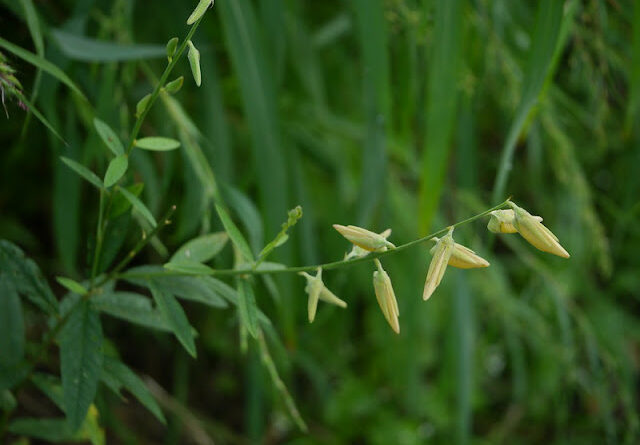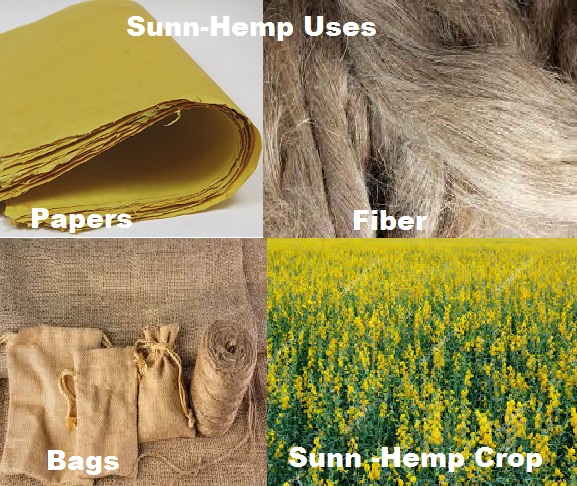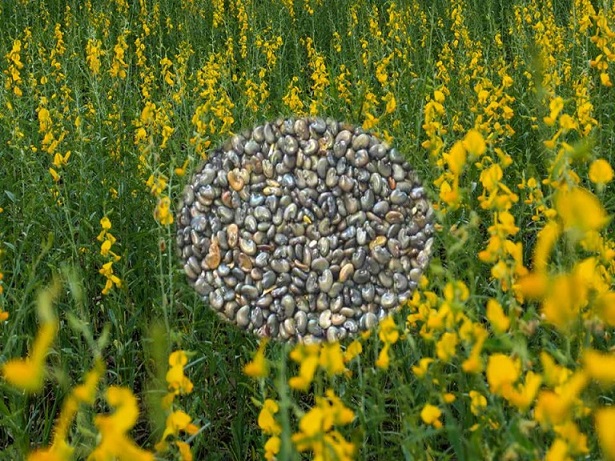Cultivation of Sunn-Hemp (Crotalaria Juncea) in India
Cultivation of Sunn-Hemp (Crotalaria Juncea) in India
Vernaculer Names of Sunn- Hemp;
Importance of Sunn-hemp Crop ;
Climatic Requirements for Sunn-Hemp Crop;
Soil Requirements for Sunn-Hemp Crop;
1) Well-drained loamy soils are best for sann-hemp cultivation.
Important Varieties of Sunn- Hemp;
Several varieties released from different states are under cultivation, which differs in their period of maturity, branching habit, and in the quantity and quality of fiber which they yield. Salient features of some of the important varieties are given below:
|
Verities |
Characterstics |
|
K-12 |
,Black Seed, harvest in 136 days, adds green biomass of 16 – 26 tonnes /ha ,Yield potential 6-10 Q/ha |
|
K-12 Yellow |
Yellow seed Coat , superior to K-12 ,Resistant to wilt, Yield potential 14 q/ha |
|
Narendra -Sanai |
Harvest in 152 days, seeds are bold and black color, average seed yield of 6-8 qt/ha. |
|
ST-95 |
Selection from a type introduced from Taiwan ,slight resistant to wilt and top shoot borer |
|
ST-55 |
Yield potential 14-15 qha’, moderately resistant to wilt |
|
ST-11 |
Selection from local types, higher fibre yielder than K-12 yellow in Uttar Pradesh |
|
SH-4 |
Selection from local types, higher yielder than K-12 yellow in Uttar Pradesh, West Bengal, Madhya Pradesh |
|
SNN-53 |
Selection row local types, suitable for West Bengal and Uttar Pradesh, yield 12 qt/ha |
|
JRJ-610 |
Yield Potential is about 10 gha’ and suitable for irrigated and rainfed, fiber quality is stronger (13.19g/ tex) |
|
SUN -37 |
Selection from accession no 037, early maturing (90-100 DAS), resistant to wilt and mosaic, yeild protential is 10-12 q/ha |
|
PAU -1691 |
Bold Seed With Black Color, Yield Potential 16-18 qt/ha |
Rotations and Mixed Cropping in Sunn-Hemp Crop ;
1) Sunn-hemp is usually sown after the harvest of Rabi crops as the main Kharif crop or an early pre-monsoon crop.
Field Preparation for Sunn-Hemp Crop ;
1) The soil should be made friable and weed-free for sowing of sann-hemp.
Seed and Sowing of Sunn-Hemp Crop;
1) Sunn-hemp seed losses its viability quickly, therefore, not older than one year seed should be used for sowing purposes.
Manures and Fertilizers Requirement in Sunn-Hemp Crop;
1) Sann-hemp being a leguminous crop fulfills its nitrogen requirement through the process of symbiotic nitrogen fixation in nodules on roots
Water Management in Sunn-Hemp Crop;
1) Generally, the crop does not require any irrigation during the Kharif season.
Weed Control in Sunn-Hemp Crop;
1) There is not much weed problem in the sann-hemp crop, because seedlings grow very fast and smother all weeds.
Diseases and Pest Management in Sunn-Hemp Crop;
Important diseases of sann-hemp are wilt; anthracnose; rust and powdery mildew.
Disease Management;
It is caused by a fungus known as Fusarium vasinfectums. This disease is sometimes very destructive. Wilt affects both young and old plants, causing them to dry up.
Control Measures
(1) Grow wilt-resistant varieties like K-12, K-12 Yellow etc.
2) Anthracnose
The disease is caused by a fungus known as Colletotrichum curvatum. the disease causes considerable damage to seedlings. Usually, the cotyledons, as well as leaves, drop out.
Control Measures
3) Rust
This disease is caused by a fungus known as Uromyces decorarus. It is responsible for considerable damage to the crop in some of the areas where sunn-hemp is grown.
Control Measures
(1) Grow resistant varieties.
2 kg in 800-1000 liters of water per hectare.
Insect Pests Management;
1) Sunn-Hemp Moth;
The caterpillars of this pest feed on the leaves and also bore into the seed pods. The caterpillars are about 3-4 centimeters long and spotted with red, dark, and white markings. The caterpillars sometimes damage the crop seriously.
Control Measures
2) Stem Borer
They bore into the stem near the nodes, causing characteristic swellings and thus affecting the fiber quality. They also bore into the top shoot of the plant resulting in the formation of galls. The affected plants become stunted and the fiber obtained is short, coarse, and specky.
Control Measures
To reduce the incidence of stem borer, three to four sprayings of prophylactic with 0.4% Diazinon (20 milliliters in 10 liters of water) reduce the incidence to a great extent.
3) Green Bug
These green bugs appear in swarms and suck the sap from leaves
Control Measures
Spray the crop with Metasystox 25 EC at the rate of 1 liter in 1000 of water per hectare.
Harvesting of Sunn-Hemp Crop ;
1) The harvesting of sunn-hemp is best done at the pod formation stage for good quality fiber. Such fibers have a good color and luster.
3) A crop of sunn-hemp grown for the purpose of green manure becomes ready for incorporation in the soil within two to three months of sowing. At this time, the stalks will be tender with very little fiber formation and will take less time for decomposition in the soil.
4) Harvesting of fiber crop is done by cutting the plants close to the ground with a sickle. The leafy top portions of the plants may be chopped off and used either as fodder or may be ploughed down to add organic matter to the soil.
Steeping, Retting, and Extraction of Sunn- Hemp Crop ;
1) The bundles are brought to the nearest ponds, ditches, pools, or streams, and arranged side by side to form a platform in-water for steeping.
7) The extraction of the fiber of sann-hemp is more difficult than jute.
8) The beat-and-jerk method is unsuitable in the case of sann-hemp as the ney of fiber to stick to the wood is more and the fiber gets entangled in broken twigs. Therefore, fiber is extracted single plant-wise by break the lower ends of the plants and then stripping upwards from the bottom.
The Yield of Sunn-hemp Crop
1) Sunn-hemp has a fiber content of 2-4 percent on the basis of the weight of the green stem or 8 to 12 percent in terms of dry weight.





